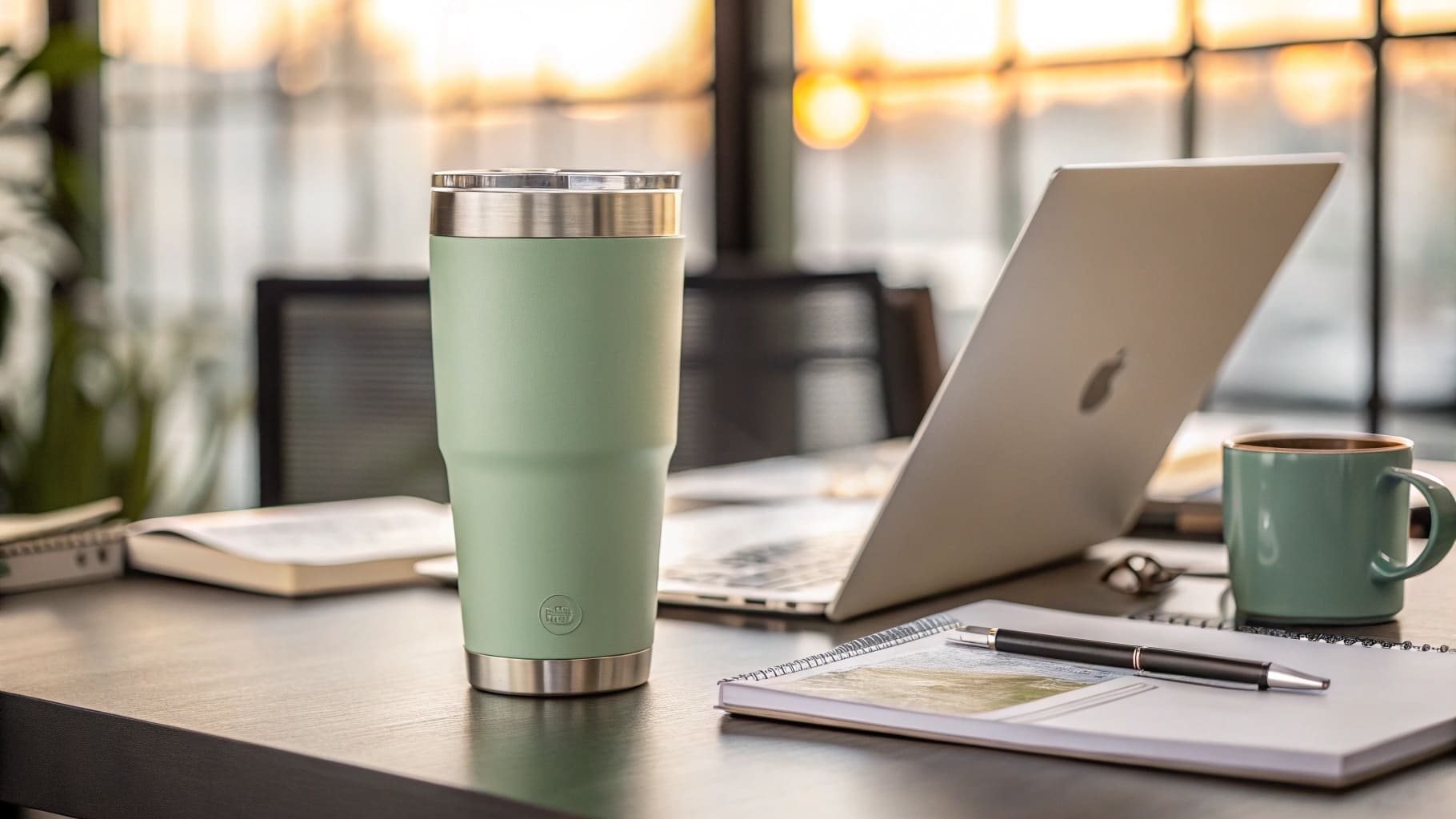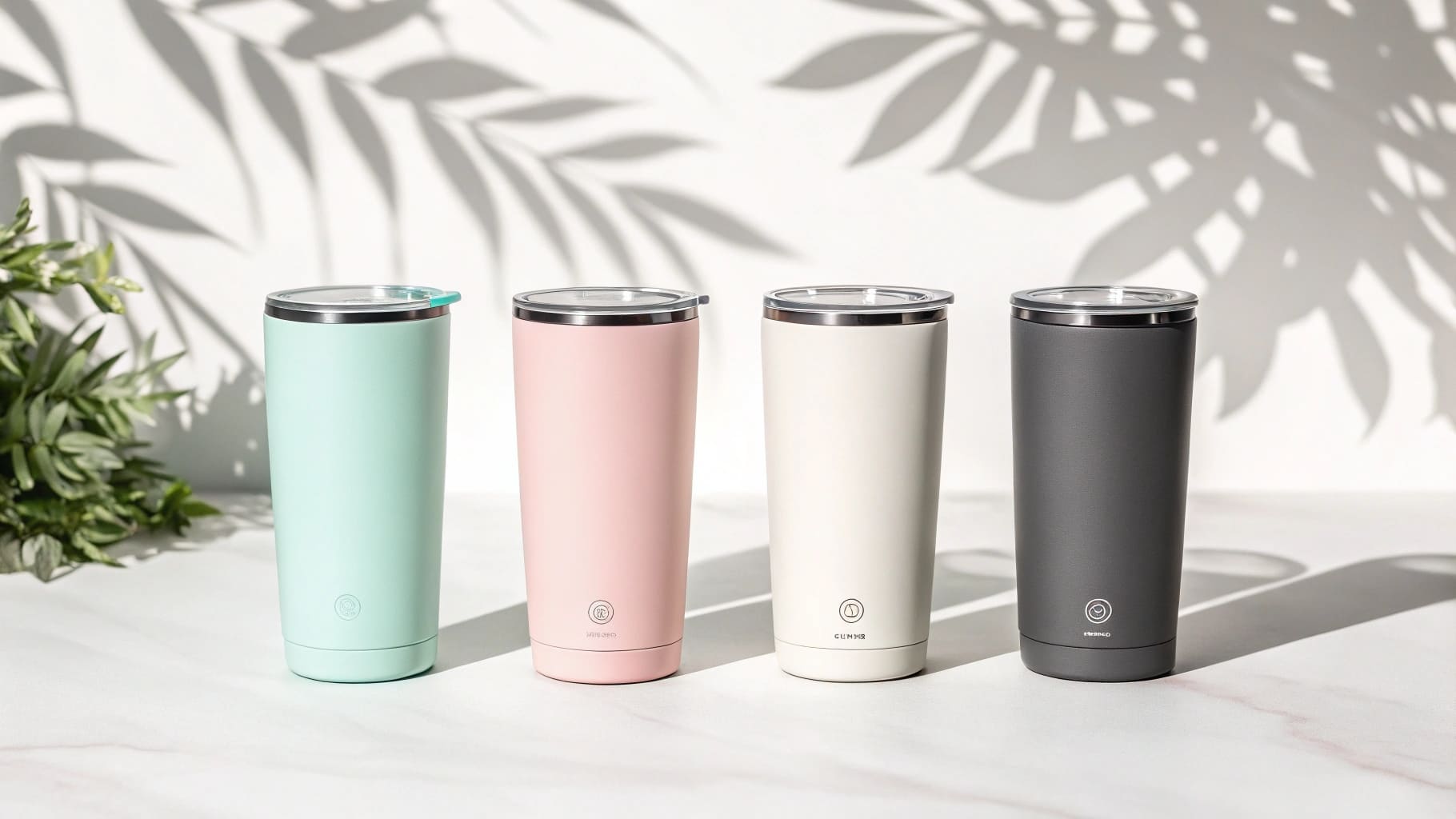Stuck choosing bottle materials for your inventory? The wrong choice can impact your profits and customer satisfaction. I'm here to help you understand the key differences.
For most B2B wholesale orders, stainless steel generally comes out on top. It offers superior durability, excellent customization options, and broad market appeal. While copper has niche advantages, stainless steel is a more practical and versatile choice for businesses.

You want the best for your customers and your brand. Making the right material choice for your water bottles is a big part of that. I've seen many clients, some with businesses like Mark Shenng in Canada who sources from us, carefully weigh these options. Let's look closer at what sets these two popular materials apart. This information will help you decide what's truly best for your inventory and your customers. Understanding these details is key to making a profitable decision.
Which is better overall for B2B, copper or stainless steel water bottles?
Confused about which material you should stock for your main product line? This critical choice directly impacts your sales and brand reputation. Stainless steel often proves to be the superior option for most business-to-business needs.
Stainless steel usually wins for B2B. It’s very tough, highly resistant to rust, and it doesn't change the taste of water. Plus, it's fantastic for branding with logos and custom colors. Copper is interesting, but stainless steel is more practical for bulk orders.

When I talk to procurement officers from large companies or startup bosses looking to build their brand, the question of "which material is better?" always comes up. For most B2B scenarios, especially when my clients are targeting markets like America and Europe, stainless steel is my top recommendation. At Icobottle, we've seen this preference play out time and again. Let me break down why.
Key Advantages of Stainless Steel for B2B
Stainless steel, particularly the food-grade 304 or 316 that we specialize in, offers a fantastic overall package for businesses.
- Durability and Performance: It's incredibly durable. Your end customers won't be coming back with complaints about rust, strange tastes in their water, or easy breakage. This reliability is a big deal for brand trust.
- Customization Potential: Stainless steel is a perfect surface for all sorts of customization. We regularly apply laser engraving, screen printing, and various powder coating finishes for our clients. This helps their brand stand out in a crowded market.
- Supply Chain & Cost: The supply chain for stainless steel is generally more robust and cost-effective, especially for large-scale production. This means we can usually handle large orders efficiently and maintain competitive pricing, which is crucial for your bottom line.
Considering Copper's Niche Appeal
Copper bottles do have a unique look, and there's a market segment that likes them for perceived health benefits and their aesthetic appeal. However, they generally require more maintenance. Copper can also react with certain acidic liquids, and not everyone appreciates the slight metallic taste it can sometimes impart. For a business that rebrands and distributes bottles, consistent quality and broad consumer appeal are vital. While copper has its place for specialized offerings, stainless steel generally meets a wider range of customer needs and business requirements.
Here's a quick comparison table:
| Feature | Stainless Steel (e.g., 304/316) | Copper |
|---|---|---|
| Overall Durability | Very High | Moderate (softer metal, prone to dents) |
| Corrosion Resistance | Excellent | Good (but will oxidize/patina) |
| Flavor Neutrality | Excellent (does not impart flavor) | Fair (can impart a slight metallic taste) |
| Branding Versatility | Excellent (many techniques) | Good (engraving, some special finishes) |
| Required Maintenance | Low | Higher (needs regular polishing to shine) |
| B2B Cost-Effectiveness | Generally Better | Can be more expensive, supply less stable |
| Broad Market Appeal | High | Niche / Specialized |
This table helps illustrate why, for many B2B buyers, stainless steel often comes out on top as the more strategic investment.
Is copper truly more sanitary than stainless steel for water bottles?
Are you worried about the hygiene aspects of the bottles you offer to your customers? The material choice plays a role here. Let's explore how copper and stainless steel compare when it comes to sanitation.
Copper is known for its natural germ-killing abilities. However, high-quality stainless steel is non-porous and exceptionally easy to clean and sanitize thoroughly. This makes stainless steel extremely hygienic for daily consumer use, often matching or exceeding practical sanitation needs.

Hygiene is a major concern for consumers today, which means it’s a critical factor for you as a B2B buyer. I often get asked if copper's well-known antimicrobial properties make it the undisputed champion of sanitation in water bottles. The reality, from my experience manufacturing and supplying both, is a bit more nuanced.
Copper's Natural Antimicrobial Edge
It's true that copper has natural antimicrobial properties. This means the metal itself can kill certain bacteria and viruses that come into contact with its surface. This is an inherent quality of copper, and it's certainly a positive point. I’ve reviewed studies that demonstrate this effect, and it’s a definite scientific advantage for copper.
Stainless Steel: The Champion of Practical Hygiene
Now, let's look at stainless steel, specifically the food-grade types like 304 and 3161 that we use at Icobottle. One of its most important hygienic features is that it's non-porous. This is crucial because it means there are very few microscopic crevices where bacteria can hide and multiply. More importantly for the end-user, stainless steel is incredibly easy to clean effectively. Your customers can typically wash it with simple soap and water, and many stainless steel bottles, including those we produce, are designed to be dishwasher safe. This ease of regular and thorough cleaning is a huge practical advantage for maintaining everyday hygiene. Think about your average customer – they want a product that is both effective and simple to keep clean.
When I discuss quality with clients, such as procurement officers who are very sensitive to product performance and safety, they appreciate that our stainless steel bottles can be easily maintained to a high standard of cleanliness by their customers. While copper has its inherent sanitation benefits, the practical, consistent hygiene achieved with easy-to-clean stainless steel2 is often more appealing and reliable for the average person's daily use.
Here’s how they generally stack up on key hygiene-related aspects:
| Aspect | Copper | Stainless Steel (Food-Grade) |
|---|---|---|
| Inherent Properties | Naturally antimicrobial (kills germs on contact) | Non-porous surface (resists bacteria hiding) |
| Bacterial Growth | Can inhibit growth on its surface | Smooth surface resists bacterial harboring |
| Ease of Cleaning | Requires specific care (avoid harsh cleaners, tarnish) | Very easy to clean with common methods |
| Dishwasher Safety | Generally No | Often Yes (check specific product) |
| Practical Daily Hygiene | Good, but cleaning method and tarnish are factors | Excellent, due to simple and effective cleaning |
So, while copper offers a special antimicrobial feature, stainless steel provides robust, easily maintained hygiene that resonates well with consumer habits.
Which material will last longer for a water bottle, copper or stainless steel?
Product lifespan is a big deal for customer satisfaction and your brand's image. Choosing a durable material is absolutely key. Let's directly compare the longevity you can expect from copper versus stainless steel bottles.
Stainless steel typically lasts longer and requires less maintenance to keep it in good condition. It's highly resistant to dents, scratches, and rust. Copper is also a robust material, but it's softer and can dent or tarnish more easily over time.

When you're investing in inventory, you naturally want products that are built to last. The durability of a water bottle directly impacts how satisfied your customers will be, and consequently, it affects your brand's reputation. Having handled and supplied thousands of both copper and stainless steel water bottles over the years, I can tell you there’s often a clear difference in their long-term performance and appearance with typical use.
Stainless Steel: Engineered to Endure
Stainless steel, especially the 18/8 (or 304 grade) and even more resilient 316 grade that we specialize in at Icobottle, is engineered for toughness and longevity.
- Resistance to Damage: It's highly resistant to dents compared to softer metals. It doesn't scratch easily from everyday bumps and scrapes.
- Corrosion Proof: Crucially, it resists rust and corrosion incredibly well, even with minimal care. This means a stainless steel bottle will maintain its structural integrity and clean appearance for a very long time.
For my B2B clients who export to demanding markets like America or Europe, providing a product that consistently withstands daily wear and tear is essential. This translates to fewer complaints, fewer returns, and ultimately, happier end-users who trust the brand.
Copper: Strong, But With Certain Conditions
Copper is also a durable metal, and a well-made copper bottle can last for many years. However, it is inherently a softer metal than stainless steel. This characteristic makes it more prone to denting if it's dropped or knocked against hard surfaces. Over time, copper also naturally oxidizes when exposed to air and moisture, developing a patina. Some people find this aged look aesthetically pleasing, but others prefer the original shiny appearance, which means regular polishing is necessary. This additional maintenance can be a drawback for busy consumers who prefer low-fuss products. For a procurement officer whose key focus includes product quality and minimizing post-sale issues, the lower-maintenance durability of stainless steel is often a significant deciding factor.
Consider these factors related to longevity:
| Feature | Stainless Steel (304/316) | Copper |
|---|---|---|
| Metal Hardness | High | Moderate (significantly softer than stainless steel) |
| Resistance to Dents | Very Good | Fair (more susceptible to denting upon impact) |
| Resistance to Scratches | Good | Fair (can scratch more easily) |
| Resistance to Corrosion/Rust | Excellent | Good (but will oxidize/tarnish/patina over time) |
| Maintenance for Original Look | Minimal (occasional cleaning) | Higher (requires polishing to maintain shine) |
| Expected Lifespan (Typical Use) | Excellent, generally maintains appearance longer | Good, but appearance changes without maintenance |
For my clients who prioritize a long-lasting product that requires minimal upkeep from the end-user, stainless steel almost always emerges as the more practical and reliable choice.
Conclusion
Choosing between copper and stainless steel depends on specific needs. However, for most B2B applications, stainless steel often offers superior durability, customization, and broader market appeal. It's a solid, reliable choice.

